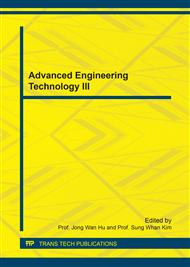[1]
J. Yang, X. H. Pan, Y. Y. Zheng, etc. Evaluation of health care function of probiotic preparation, Shanghai J. Prev. Med. 2 (2000) 73-75.
Google Scholar
[2]
Q. Li, S. C. Zhang, X. Y. Zeng, etc. Probiotics nutrition and its health care function, Food Res. Dev. 25(02) (2004) 106-109.
Google Scholar
[3]
H. Wei, C. M. Liu, B. C. Cheng, etc. Development of Beneficial Health Effects of Viable and Non-viable Probiotics Cells, Food Sci. 28(11) (2007) 618-623.
Google Scholar
[4]
X. Z. Hu. Probiotics, prebiotics and health care function and safety, Shanghai Med. Pham. 22(8) (2001) 356-358.
Google Scholar
[5]
X. H. Guo. Foundation and Application of Probiotics. 2002, Beijing: Beijing Scientific and Technical Publishers.
Google Scholar
[6]
G. Zhang. Lactic Acid Bacteria-Basis, Technology and Application. 2007, Beijing: Chemical Industry Press.
Google Scholar
[7]
L. Zhang, B. P. Tan, K. S. Mai, etc. Screening and Identification of a Potential Probiotic in Shrimp, Fenneropenaeus chinensis, Period. Ocean Univ. Chin. 38(02) (2008) 225-231.
Google Scholar
[8]
H. B. Li, X. L. Song, S. Wei, etc. Screening and identification of four probiotic bacteria isolated from intestine of shrimp, Ocean Limin Sin. 39(04) (2008) 374-380.
Google Scholar
[9]
Y. Liu, C. Y. Song, W. L. He, etc. Characterization of the orientation of ethanol-water clusters by polarized fluorescence spectrum, Acta. Phys. Sin. 56(05) (2007) 2962-2967.
Google Scholar
[10]
Y. Liu, X. W. Ni. The fluorescence spectral characteristics and the emission mechanism of ethanol excimer in water solution, Acta. Phys. Sin. 58(05) (2009) 3572-3577.
Google Scholar
[11]
J. F. Zhang, S. S. Hu. Chaotic time series prediction based on RBF neural networks with a new clustering algorithm, Acta. Phys. Sin. 56(02) (2007) 713-719.
DOI: 10.7498/aps.56.713
Google Scholar
[12]
L. Cheng, X. L. Ding, Z. G. Liu, etc. A newly micro-X-ray fluorescence spectrometer and applications for non-destructive analysis of archaeological objects, Acta. Phys. Sin. 56(12) (2007) 6894-6898.
DOI: 10.7498/aps.56.6894
Google Scholar
[13]
R. C. Chin, M. W. Mayo, W. Hallidy, etc. Compact phase resolved fluorescence spectrometer for detection and discrimination of airborne and waterborne bacteria, SPIE, 2836 (1996) 158-169.
Google Scholar
[14]
D. Stephan, M. L. Jörg, R. Rainer, R. Jürgen. Ultraviolet fluorescence excitation and emission spectroscopy of marine algae and bacteria, Marine Chem. 62(1-2) (1998) 137-156.
DOI: 10.1016/s0304-4203(98)00026-7
Google Scholar
[15]
E. G. Héctor, S. J. Landulfo, A. Z. Renato, T. Marcos. Rapid Identification of Bacterial Species by Fluorescence Spectroscopy and Classification Through Principal Components Analysis, J. Fluorensc. 13(3) (2003) 489-493.
DOI: 10.1023/b:jofl.0000008059.74052.3c
Google Scholar
[16]
S. Elliott, J. R. Lead, A. Baker. Thermal quenching of fluorescence of freshwater, planktonic bacteriaOriginal Research Article, Anal. Chim. Acta. 564(2) (2006) 219-225.
DOI: 10.1016/j.aca.2006.01.087
Google Scholar
[17]
Research and Development Center of Feisi Science and Technology Products 2005 Neural Networks and Realized by Matlab7 . Beijing: Publishing House of Electronics Industry, (2005).
Google Scholar
[18]
C. H. Dong. Matlab Neural Networks and Application (2nd Ed. ), Beijing: National Defense Industry Press, (2007).
Google Scholar
[19]
S. M. Ma, S. D. Liu, Z. Y. Zhang, etc. Radial Basis Function Networks and IR Spectrometry Applied for Identification of Official Rhubarb Sample, Spectrosc. Spectr. Anal. 25(06) (2005) 874-877.
Google Scholar
[20]
Y. B. Li, X. Y. Huang, M. Sha, etc. Radial basis function neural network for overlapping chromatographic peaks, Chromat. 19(02) (2001) 112-115.
Google Scholar
[21]
X. H. Yu, Z. Y. Zhang, Q. Ma, etc. Quantitative Prediction of Active Constituents in Rhubarb by Near Infrared Spectroscopy and Radial Basis Function Neural Networks, Spectrosc. Spectr. Anal. 27(03) (2007) 481-485.
Google Scholar
[22]
K. Wang, H. Zhang, S. J. Chang, etc. Adaptive wavelet algorithm for complicated spectra data compression, Acta. Phys. Sin. 56(06) (2007) 3613-3618.
Google Scholar
[23]
H. P. Zhang, J. B. Zhao, Z. L. Yang. Wavelet Transform and Its Application in Data Compression, Comput. Modern. 11 (2003) 105-106.
Google Scholar


